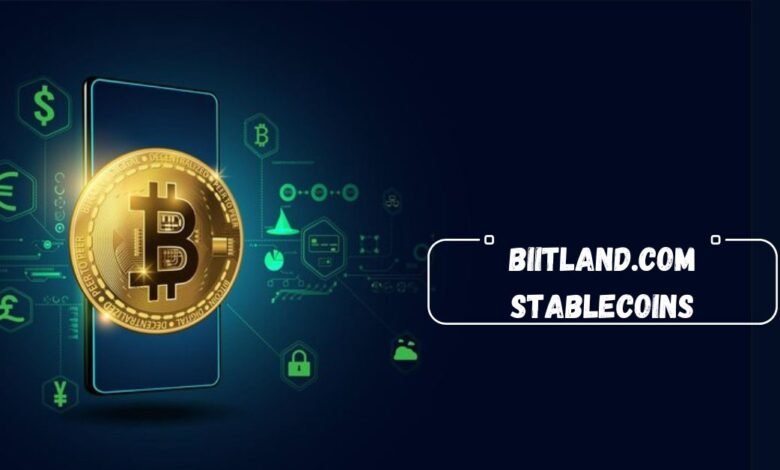The world of digital currency is evolving at an unprecedented pace, and among the many innovations emerging from this financial revolution, stablecoins are capturing significant attention. These unique assets aim to bridge the gap between volatility and stability in cryptocurrency markets. With platforms like Biitland.com leading the charge, stablecoins have become a hot topic for investors and everyday users alike.
But what exactly are stablecoins? Why do they matter so much in today’s economy? This post will unravel these questions while exploring how Biitland.com Stablecoins can redefine your understanding of digital money. Buckle up as we dive into the future of finance!
Table of Contents
Understanding Biitland.com Stablecoins
Stablecoins are digital currencies designed to maintain a stable value against traditional assets, like fiat currencies. Unlike Bitcoin or Ethereum, which can experience wild price swings, stablecoins aim for consistency.
They achieve this stability through various mechanisms. Some are pegged directly to a specific currency, such as the US dollar. Others use algorithms that adjust supply based on market demand.
This unique structure makes them attractive for users seeking the benefits of cryptocurrency without the inherent risks of volatility. With stablecoins, transactions become more predictable and efficient.
Additionally, they open doors for innovation in payments and remittances. As blockchain technology advances, understanding these digital assets becomes crucial for navigating the evolving financial landscape.
The Advantages of Biitland.com Stablecoins
Stablecoins offer a unique blend of stability and flexibility in the digital currency landscape. Their value is pegged to traditional assets, such as fiat currencies like the US dollar or commodities like gold. This design significantly reduces volatility compared to cryptocurrencies like Bitcoin and Ethereum.
One major advantage is their potential for seamless transactions. Users can send money quickly across borders without worrying about fluctuating values during transfers. This efficiency makes stablecoins appealing for both individuals and businesses.
Additionally, stablecoins enhance accessibility to digital finance. They provide a gateway for those who may not have access to conventional banking services but still want to participate in global markets.
Security is another key benefit. Most reputable stablecoin platforms prioritize transparency and regulatory compliance, giving users confidence in their investments while fostering trust within the ecosystem.
The Different Types of Biitland.com Stablecoins
Stablecoins come in various forms, each serving unique purposes within the digital currency landscape. The most common types include fiat-collateralized stablecoins, which are backed by traditional currencies like the US dollar or euro. This backing provides a sense of security for users.
Another category is crypto-collateralized stablecoins. These are supported by other cryptocurrencies, often overcollateralized to absorb price volatility effectively. They offer more decentralized alternatives but can be complex in their mechanics.
Algorithmic stablecoins operate differently altogether. Instead of being tied to physical assets, they use algorithms and smart contracts to control supply based on demand fluctuations. This creates a self-stabilizing mechanism that aims to maintain value without direct collateralization.
Each type reflects different philosophies about stability and risk management in the evolving world of digital finance while catering to diverse user needs across various platforms.
How Biitland.com Stablecoins Work
Biitland.com Stablecoins operate by pegging their value to stable assets, such as fiat currencies or commodities. This mechanism provides a reliable price point, helping users avoid the wild fluctuations often seen in traditional cryptocurrencies.
When you transact with Biitland.com Stablecoins, you’re engaging in a system designed for stability and security. The platform uses advanced blockchain technology to ensure transparency and trustworthiness in every transaction.
Users can easily convert their holdings into other cryptocurrencies or traditional money at any time. This flexibility makes Biitland.com Stablecoins an attractive option for both casual users and investors looking to minimize risk while maximizing potential gains.
Moreover, smart contracts facilitate automated processes within the ecosystem. These contracts execute transactions based on predefined conditions without the need for intermediaries, streamlining operations and enhancing efficiency across all activities related to stablecoin use.
Use Cases for Stablecoins in Today’s Economy
Stablecoins are transforming various sectors of the economy. One prominent use case is in remittances. Sending money across borders can be costly and slow, but with stablecoins, transactions become faster and more affordable.
E-commerce platforms are also embracing these digital currencies. Customers can make purchases without worrying about crypto volatility. This encourages more people to participate in online shopping using blockchain technology.
Additionally, decentralized finance (DeFi) has gained traction thanks to stablecoins. They enable users to lend or borrow assets while minimizing risk exposure associated with price fluctuations.
In investment portfolios, stablecoins serve as a safe haven during market downturns. Investors can quickly move funds into stable assets, retaining value until they feel comfortable reinvesting elsewhere.
Businesses utilize stablecoins for payroll solutions. It simplifies compensation processes in international teams by eliminating currency conversion fees and delays.
Potential Challenges and Risks
While Biitland.com stablecoins offer numerous benefits, they are not without challenges. One significant concern is regulatory scrutiny. Governments worldwide are still figuring out how to classify and regulate these digital assets.
Another risk lies in the reliance on collateral. If the backing asset’s value fluctuates significantly, it can undermine the stability that stablecoins aim to provide. This instability can create trust issues among users.
Security vulnerabilities also pose a threat. Cyberattacks targeting stablecoin platforms could lead to substantial financial losses for investors and users alike.
Market sentiment plays a crucial role. If confidence wanes due to negative news or events, even well-structured stablecoins may face volatility reminiscent of traditional cryptocurrencies. Awareness of these risks is essential for anyone considering involvement with Biitland.com stablecoins.
Will Stablecoins Take Over Traditional Currency?
The rise of stablecoins has sparked a fascinating debate about their potential to replace traditional currency. With digital assets gaining traction, many wonder if these cryptocurrencies can truly stand on par with established money.
Stablecoins offer the promise of reduced volatility, making them appealing for everyday transactions. Their ability to maintain a fixed value against fiat currencies could reshape how people perceive and use money in daily life.
However, widespread adoption faces challenges. Regulatory hurdles loom large, as governments strive to create frameworks that ensure consumer protection and financial stability.
Moreover, trust plays a crucial role. Will users feel comfortable shifting from familiar cash systems to the uncertain terrain of digital currencies?
While stablecoins present an intriguing alternative, their long-term impact on traditional currency remains uncertain at this stage in the evolution of finance.
Conclusion
The rise of Biitland.com Stablecoins marks a significant shift in the landscape of digital currency. These innovative financial instruments offer an intriguing solution to the volatility often associated with cryptocurrencies. By pegging their value to stable assets, they provide users with more predictable and reliable pricing.
Through understanding how these stablecoins function, it becomes clear that they can enhance everyday transactions and support broader economic activities. Their advantages—such as low transaction fees and speedy transfers—are making them increasingly appealing for both individual users and businesses alike.
However, potential challenges remain on the horizon. Regulatory scrutiny, security concerns, and market adoption are factors that could influence their long-term viability. The question of whether stablecoins will overtake traditional currencies is complex but thought-provoking.
As we move forward into this new era of finance, one thing is certain: Biitland.com Stablecoins are poised to play a pivotal role in shaping our economic future while fostering innovation within the digital currency space.


 Plumber Crypto Time Travel Ad: The Viral Sensation Explained
Plumber Crypto Time Travel Ad: The Viral Sensation Explained